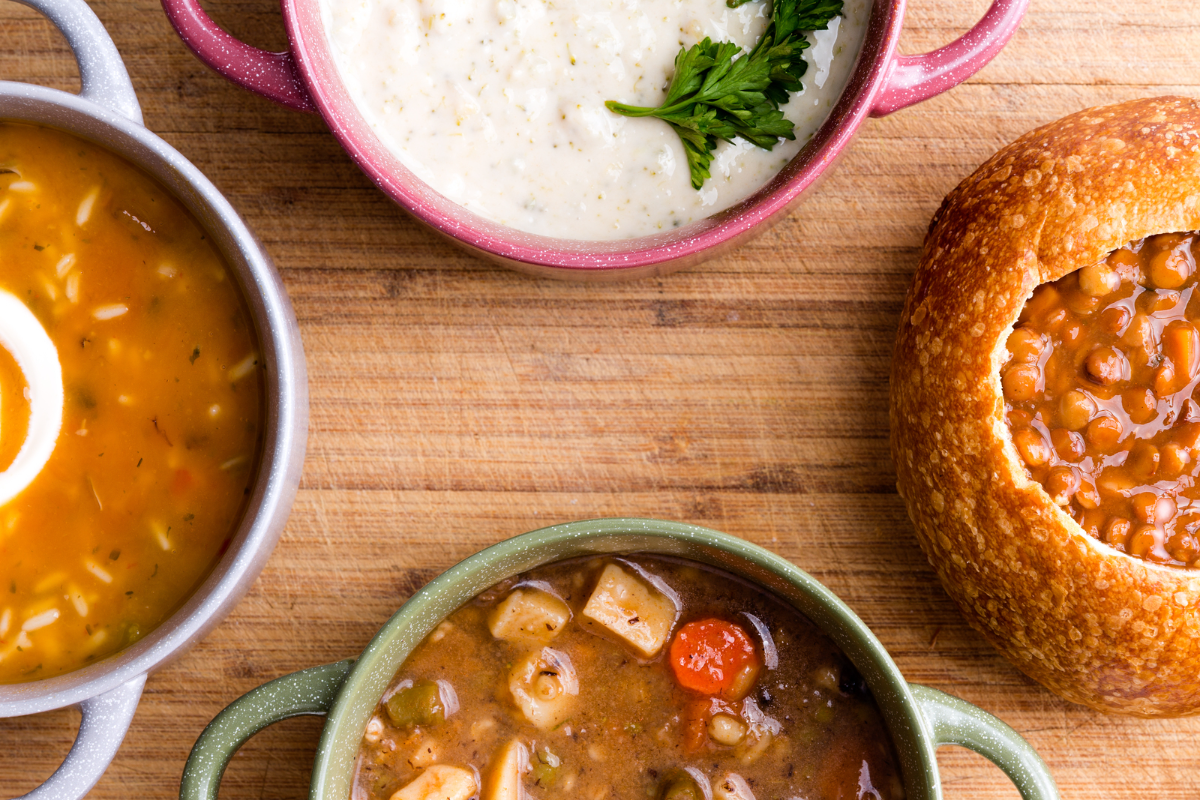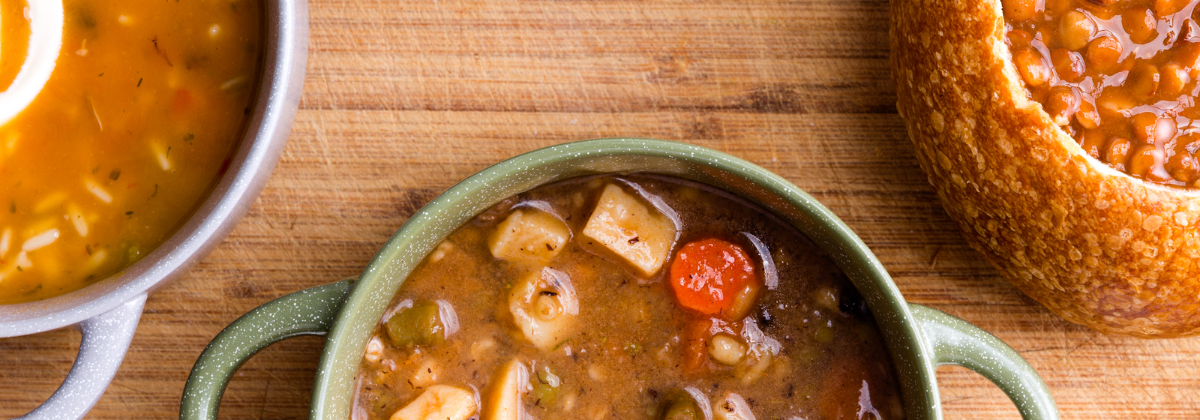Knowing how to make soup creamy or how to make soup less salty is all well and good, but if you don’t know what type you’re making, then it’s all in vain. There are hundreds of types, tons of variations, and thousands of ingredient combos for different types of soup. So, what’s what?
Allow me to help! Types of soup include clear, thick, cold, and National soups. But these also have tons of different varieties under them that I’ll also be covering. So, let’s get right in.

Contents
Understanding Soup Foundations
Stocks and Broths
Stocks and broths are the foundation of many types of soup and stews. The main difference is that stocks are made with bones, while broths are made with meat. Chicken broth, vegetable broth, and beef broth are all common types of broth, with all of them having stock versions as well.
Thickness
The thickness of a soup significantly defines its type. Various techniques, such as roux, vegetable purees, and cream, are employed to manipulate soup thickness and its kind.
Soup Ingredients
Proteins: Proteins are an important component of many soups, as they add the flavor, texture, and nutritional value a soup needs. Some common proteins used in soup include meat, seafood, and beans.
Vegetables and Legumes: Vegetables and legumes are a valued component of soup as they add flavor, texture, and nutritional value. Some popular vegetables used in soup include onions, garlic, tomatoes, and broccoli. Legumes, such as beans and lentils, are high in protein and fiber.
Herbs and Seasonings: These are what give soup their fresh and iconic flavor. Common herbs used include rosemary, sage, and thyme. Common seasonings used are salt, pepper, and ginger.
Main Types of Soup
Clear Soups
Clear soups are light and refreshing soups made from a clear broth or stock. They’re typically served as a starter or appetizer. Some popular clear soups include consommé, chicken noodle soup, and brothy soup.
Thick Soups
Thick soups are heartier and more filling than clear soups. They’re made with a roux of butter and flour, which gives them a creamy texture. Some popular thick soups include chowder, bisque, and cream of mushroom soup.
Specialty and National Soups
Specialty and national soups are typically made with special ingredients and flavors specific to a certain region or culture. Some popular specialty and national soups include gazpacho from Spain, borscht from Russia, minestrone soup from Italy, French onion soup from France, Italian wedding soup, miso soup from Japan, and Chinese egg drop soup. You can even find specialty soups from fast food restaurants.
Different Types of Soup
Clear Soups
- Consommé – This is a clear and flavorful broth made by clarifying stock with egg whites and vegetables.
- Miso Soup – Miso is a traditional Japanese soup made with dashi stock and fermented soybean paste, often containing tofu and seaweed.
- Chicken Broth – Chicken broth is a simple, classic, and nourishing soup made by simmering chicken and vegetables in water.
- Egg Drop Soup – A Chinese soup featuring wisps of beaten egg in a clear broth, often with scallions and tofu.
- Gazpacho – This is a refreshing Spanish cold soup made from blended tomatoes, cucumbers, peppers, and other vegetables.
Thick Soups
- Clam Chowder – Clam chowder is a creamy and hearty soup made with clams, potatoes, onions, and celery in a rich, thickened broth.
- Tomato Bisque – This tomatoey treat is a smooth and velvety soup made from puréed tomatoes, cream, and aromatic herbs.
- Potato Leek Soup – Potato leek soup is a comforting soup made with puréed potatoes, leeks, onions, and broth, often finished with cream.
- Butternut Squash Soup – This is a sweet and savory soup made from puréed roasted butternut squash, onions, and spices, often with a touch of cream.
- Lentil Soup – A delicious filling and nutritious soup made with lentils and vegetables and often flavored with spices like cumin and coriander.
National Soups
- French Onion Soup – This is a true classic. French onion soup is a rich and comforting soup featuring caramelized onions, beef broth, and a toasted baguette topped with melted cheese.
- Pho – Pho is a Vietnamese noodle soup with aromatic broth, rice noodles, and various cuts of meat, often served with fresh herbs and lime on the side.
- Minestrone – Minestrone is a classic Italian vegetable soup with tomato-based broth, beans, pasta, and a variety of seasonal vegetables.
- Borscht – Borscht is a traditional Eastern European soup made with beets, cabbage, and other root vegetables, often served with a dollop of sour cream.
- Tom Yum – Tom Yum is a spicy and sour Thai soup flavored with lemongrass, lime leaves, and chili, often containing shrimp or chicken.
Preparation and Cooking Techniques
Soup Bases and Building Flavors
The base is what gives the soup its flavor and depth. It’ll vary depending on the types of soup you make. You can also use water as a base, but it’ll not give your soup as much flavor. To build flavor in your soup, you can add aromatics such as onions, garlic, and celery. You can also sauté your aromatics or deglaze your pot with wine or vinegar.
Cooking Methods
The most common methods for cooking soup are simmering and boiling. Simmering and boiling play crucial roles in soup-making by extracting flavors from ingredients, breaking down tough proteins, and creating a tastier blend of flavors. Simmering allows a richer and more complex taste to form while boiling helps to soften tougher ingredients quickly.
I’d like to mention that storing and freezing is just as important as cooking the soup, so use my guide to freezing soup for the best possible results.

Adjusting Soup Consistency
Knowing how to thicken soup or adjust the consistency will help the flavor of it. To thicken your soup, you can make a roux and whisk it into your soup. If you want to puree your soup for a thicker consistency, you can use a blender or an immersion blender. If you also want to make soup creamier, you can add cream to your soup.
Frequently Asked Questions
Generally, soups that are broth-based and loaded with vegetables are the healthiest options. Examples of healthy soups include vegetable soup, chicken noodle soup, and lentil soup.
The most popular soups in the world are tomato soup, chicken noodle soup, clam chowder, miso soup, ramen, French onion soup and minestrone.
The main categories of soup include broth-based soups, cream soups, pureed soups, and chunky soups.
If you’re cooking for picky eaters, you can’t go wrong with chicken noodle soup, vegetable soup, and Tomato soup. These are delicious classic options.
